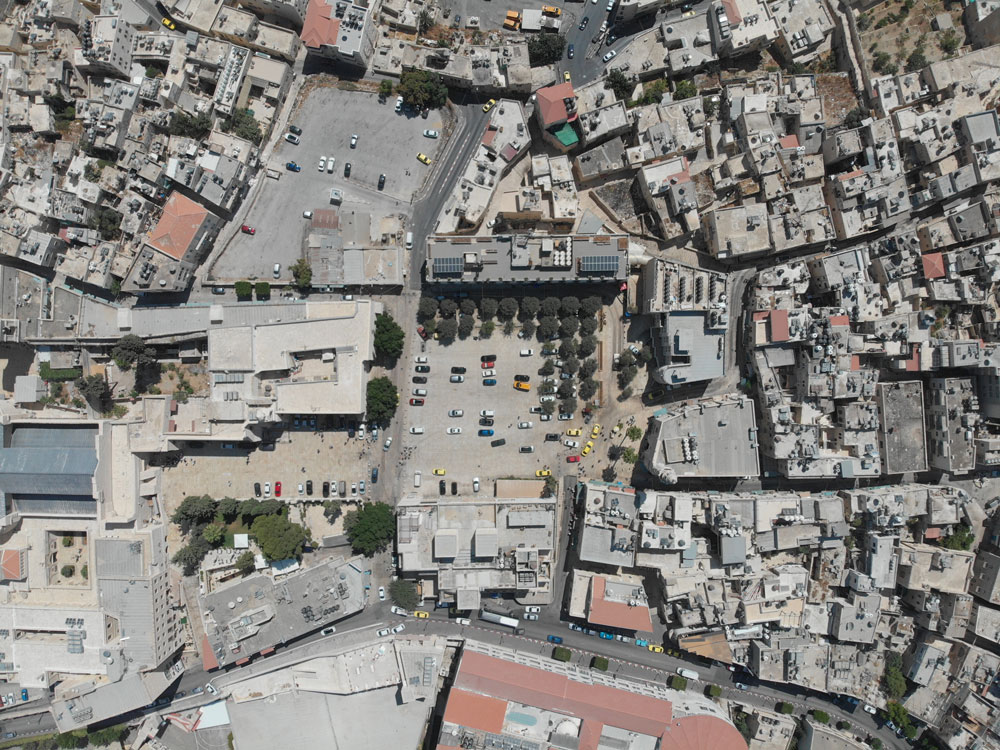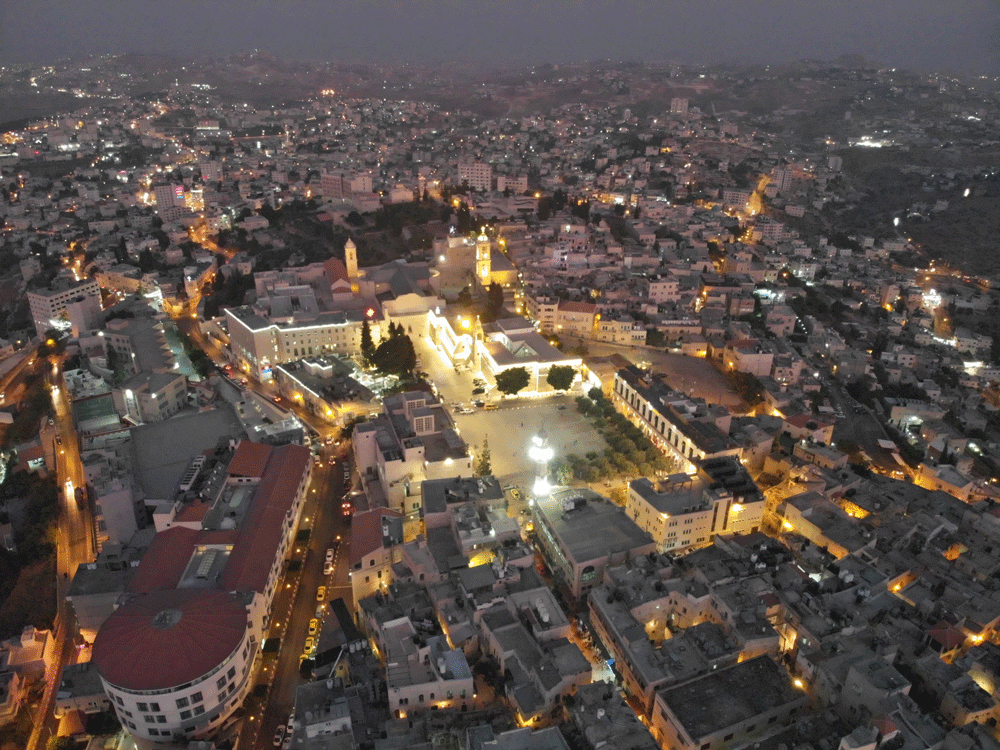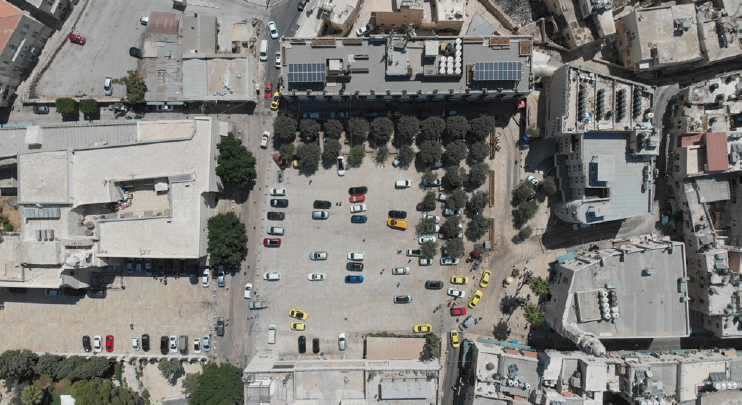 Nativity square
Nativity square  ساحة المهد
ساحة المهد 
Issue de plusieurs aménagements successifs tout au long du 19ème et du 20ème siècle, la place de la Nativité est l’unique espace public d’envergure de Bethléem et l’un des plus importants de Palestine, voire du Moyen orient, par ses dimensions.
Il s’agit d’un espace clé pour le fonctionnement et la vie citoyenne de la ville. Elle est le support de nombreux rassemblements et manifestations religieuses, sociales ou politiques. Lors des célébrations de Noël, la place de la Nativité devient le coeur battant de la vie locale. La place est située en bordure de la Basilique de la Nativité, premier site palestinien classé au patrimoine mondial de l’UNESCO en 2012. Elle peut également être appelée place de la mangeoire ou place de la crèche, par extension du parvis devant la Basilique. Au sein d’une ville dense, elle constitue avec le parking arménien, un vide urbain qui permet de créer un écrin autour de la Basilique.

La place est bordée de plusieurs espaces symboliques : la mosquée d’Omar, unique mosquée de la vieille ville, le centre pour la Paix peu fréquenté et qui comprend un musée sur l’histoire de la ville et l’office de tourisme, un centre d’accueil des visiteurs géré par la communauté des franciscains, des cafés et boutiques pour touristes abritées sous des arcades commerciales et les bâtiments de la Municipalité.
Les voitures circulent autour de la place et y stationnent en journée. Le soir, l’animation est limitée à des rassemblements de jeunes et de vendeurs ambulants. À l’échelle des rues étroites de la vieille ville, la circulation reste omniprésente et freine le développement touristique. L’UNESCO alarme régulièrement les autorités locales sur les risques de dégradation de ce patrimoine inestimable.
La réhabilitation de la place sera réalisée grâce à une approche créative et participative avec le soutien d’architectes, designers et artistes locaux et internationaux et en partenariat avec l’UNESCO. Des ateliers entre étudiants français et palestiniens seront organisés, ainsi qu’un concours d’architecture et de design. L’expertise d’usage des habitants et des touristes sera mobilisée pour répondre au plus près des besoins et renforcer l’appropriation et l’animation de l’espace public.
Il s’agit de réaliser un projet « vitrine » pour rééquilibrer l’espace public en faveur des piétons et activer de nouveaux usages : marcher, s’asseoir, flâner, jouer, se rencontrer, se reposer, etc. La place des femmes, des enfants, des personnes à mobilité à réduite, le rôle de la nature en ville, l’expérience touristique ou encore la cohésion sociale seront
au coeur des enjeux.
Les aménagements seront réalisés avec les habitants, en valorisant les savoir-faire ancestraux autour de la pierre et de l’artisanat (bois d’olivier, broderie, mosaïque). Des ateliers construction, signalétique, graphisme et jardinage seront encadrés par des professionnels. Des activités ludiques et sportives seront organisées avec les acteurs de la société civile (scouts, clubs sportifs, coopératives de femmes) pour activer la vie culturelle et sociale. Il s’agira de modifier en douceur la perception de l’espace et d’enclencher la réappropriation de la place par les usagers.
Le marché de noël sera redynamisé en partenariat avec la Ville de Strasbourg. Enfin, des chantiers éducatifs et d’insertion autour des filières du bois, de la pierre et de la construction seront menés entre jeunes palestiniens issus des quartiers défavorisés et des camps de réfugiés et des jeunes parisiens en rupture scolaire et sociale.
Nativity square is the only major public space in Bethlehem and one of the most important in Palestine, and even in the Middle East, due to its size.
It is a key space for the functioning and civic life of the city. It supports many religious, social and political gatherings and events. During Christmas celebrations, the Nativity square becomes the beating heart of local life. The square is located on the edge of the Basilica of the Nativity, the first Palestinian site classified as World Heritage by UNESCO in 2012. It can also be called the place of the manger or place of the manger, by extension of the forecourt in front of the Basilica. In the heart of a dense city, with the Armenian car park, it forms an urban void that creates a setting around the Basilica.
The square is lined with several symbolic spaces: the mosque of Omar, the only mosque of the old city, the center for the peace and quiet which includes a museum on the history of the city and the tourist office, a center Visitor reception run by the Franciscan community, cafes and tourist shops sheltered under commercial arcades and the buildings of the Municipality.
Cars circulate around the square and park there during the day. In the evening, entertainment is limited to gatherings of young people and street vendors. At the scale of the narrow streets of the old city, traffic remains ubiquitous and hampers tourism development. UNESCO regularly warns local authorities about the risks of degradation of this invaluable heritage. The rehabilitation of the square will be achieved through a creative and participatory approach with the support of architects, designers and local and international artists and in partnership with UNESCO.
Workshops between French and Palestinian students will be organized, as well as a competition of architecture and design. The expertise of use of residents and tourists will be mobilized to meet the needs as closely as possible and strengthen the ownership and animation of the public space.
It is about a showcase project to rebalance the public space in favor of pedestrians and activate new uses: walking, sitting, strolling, playing, meeting, resting, etc. The place of women, children, people with reduced mobility, the role of nature in the city, the tourist experience or social cohesion will be at the heart of the issues.
The arrangements will be made with the inhabitants, valuing the ancestral know-how around stone and crafts (olive wood, embroidery, mosaic). Construction, signage, graphic design and gardening workshops will be supervised by professionals. Fun and sports activities will be organized with civil society actors (scouts, sports clubs, women’s cooperatives) to activate cultural and social life. It will be a question of gently modifying the perception of the space and to trigger the reappropriation of the place by the users.
The Christmas market will be revitalized in partnership with the City of Strasbourg. Finally, educational and integration projects around the wood, stone and construction sectors will be conducted between young Palestinians from disadvantaged neighborhoods and refugee camps and young Parisians who are out of school and social.
مكان المهد هو المساحة العامة الرئيسية الوحيدة في بيت لحم وواحدة من أكبر المساحات في فلسطين ، أو حتى الشرق الأوسط ، بسبب حجمها. إنها مساحة أساسية لتشغيل وحياة المدينة المدنية. وهو يدعم العديد من التجمعات والأحداث الدينية والاجتماعية والسياسية. خلال احتفالات عيد الميلاد ، يصبح ميدان المهد قلبًا نابضًا للحياة المحلية. يقع الميدان على حافة كنيسة المهد ، وهو أول موقع فلسطيني صنفته اليونسكو في عام 2012 باعتباره تراثًا عالميًا.
ويمكن أيضًا تسميته مكان المذود أو مكان المذود ، امتدادًا للواجهة الأمامية للكنيسة. في قلب مدينة كثيفة ، مع موقف السيارات الأرمني ، يشكل الفراغ الحضري الذي يخلق محيطًا حول الكنيسة. تصطف الساحة بالعديد من المساحات الرمزية: مسجد عمر ، المسجد الوحيد في المدينة القديمة ، مركز السلام والهدوء الذي يضم متحفًا عن تاريخ المدينة والمكتب السياحي ومركزًا حفل استقبال الزوار الذي تديره جماعة الفرنسيسكان والمقاهي والمحلات السياحية المحمية تحت الأروقة التجارية ومباني البلدية. السيارات تدور حول الساحة وتوقف هناك خلال اليوم. في المساء ، يقتصر الترفيه على تجمعات الشباب والباعة المتجولين. على نطاق الشوارع الضيقة في المدينة القديمة ، لا تزال حركة المرور
في كل مكان وتعرقل التنمية السياحية. تحذر اليونسكو بانتظام السلطات المحلية من مخاطر تدهور هذا التراث الثمين. سيتم تحقيق إعادة تأهيل الساحة من خلال نهج إبداعي وتشاركي بدعم من المهندسين المعماريين والمصممين والفنانين المحليين والدوليين وفي شراكة مع اليونسكو.

سيتم تنظيم ورش عمل بين الطلاب الفرنسيين والفلسطينيين ، بالإضافة إلى مسابقة للهندسة المعمارية والتصميم. سيتم تعبئة خبرة استخدام السكان والسائحين لتلبية الاحتياجات بأكبر قدر ممكن وتعزيز ملكية الرسوم المتحركة والأماكن المتحركة. إنه يتعلق بمشروع عرض لإعادة توازن المساحة العامة لصالح المشاة وتفعيل الاستخدامات الجديدة: المشي ، الجلوس ، المشي ، اللعب ، الاجتماع ، الراحة ، إلخ. سيكون مكان النساء ، الأطفال ، الأشخاص ذوي القدرة المحدودة على الحركة ، دور الطبيعة في المدينة ، التجربة السياحية أو التماسك الاجتماعي في قلب هذه القضايا. سيتم اتخاذ الترتيبات مع السكان ، وتقييم الدراية القديمة حول الحجر والحرف (خشب الزيتون والتطريز والفسيفساء).
سيتم الإشراف على أعمال البناء واللافتات وتصميم الجرافيك وورش العمل من قبل محترفين. سيتم تنظيم الأنشطة الترفيهية والرياضية مع الجهات الفاعلة في المجتمع المدني (الكشافة والنوادي الرياضية والتعاونيات النسائية) لتفعيل الحياة الثقافية والاجتماعية. ستكون مسألة تعديل التصور الخاص بالفضاء بلطف وإثارة إعادة تخصيص المكان من قبل المستخدمين. سيتم تنشيط سوق الكريسماس بالشراكة مع مدينة
ستراسبورغ. أخيرًا ، سيتم تنفيذ مشاريع تعليمية وتكاملية حول قطاعات الخشب والحجر والبناء بين الشباب الفلسطينيين من الأحياء المحرومة ومخيمات اللاجئين والشباب الباريسيين الذين هم خارج المدرسة والاجتماعية.

